For the Ancestors and for Peace: A Conversation with the Organizers of “May We Gather”
By Harsha Menon
Buddhistdoor Global
| 2021-07-02 | 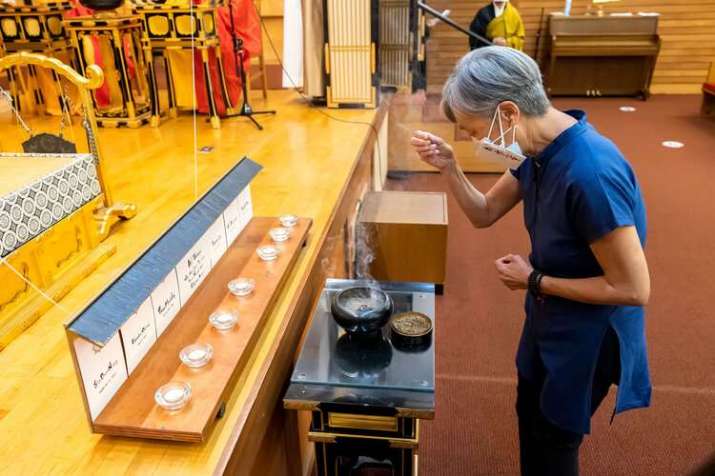 Tenzin Kiyosaki. Image courtesy of Tauran Photography, tauran.com
Tenzin Kiyosaki. Image courtesy of Tauran Photography, tauran.comBuddhist monastics and teachers from diverse lineages joined together on 4 May 2021 for the first national Buddhist memorial service in response to anti-Asian violence. The event, “May We Gather: A National Buddhist Memorial Ceremony for Asian American Ancestors,” which was held in person and shared via livestream, marked a historic collective experience in the history of American Buddhism. What began in tragedy, transformed over those few hours into an expression of solidarity and community.
After the event, I spoke with the organizers, Chenxing Han, a writer and Buddhist studies scholar; Funie Hsu, a transdisciplinary scholar and professor; and Duncan Ryuken Williams, a writer, scholar, professor, and Buddhist priest in the Soto Zen tradition.
Buddhistdoor Global: How did you conceive the event?
Chenxing Han: It happened quite organically. In late February we met to discuss the possibility of writing a statement on anti-Asian violence that centered Asian American Buddhists. As we continued to meet in subsequent weeks, we began brainstorming ways we might craft a compelling response beyond a simple written statement. Then the Atlanta-area shootings happened, and it felt urgent to meet the magnitude of the moment. Duncan suggested a national Buddhist memorial ceremony. As we drafted the invitation, Funie came up with the “May We Gather” theme. I suggested that the event be held 49 days after the Atlanta shooting.
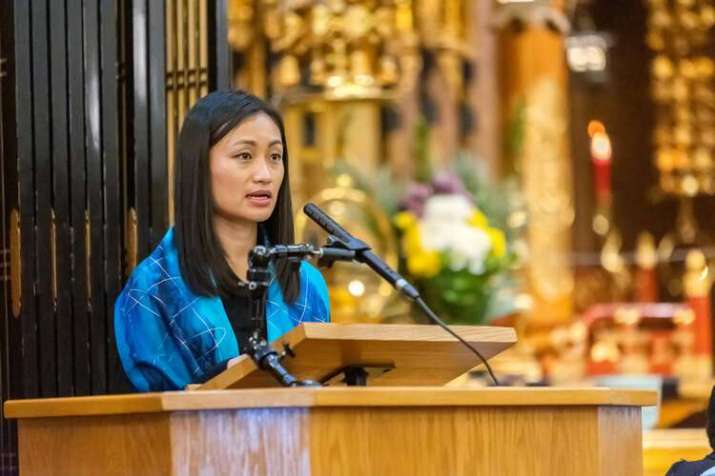 Chenxing Han. Image courtesy of Tauran Photography, tauran.com
Chenxing Han. Image courtesy of Tauran Photography, tauran.comBDG: In the horrific killings of eight people in Atlanta, six of the victims were Asian females. Were all six also Buddhists?
CH: No. We only know for sure that Yong Ae Yue was Buddhist, although there were Buddhist elements at a funeral for Dao Youfeng. The 4 May ceremony centered on a set of memorial tablets with the names of six Asian American Buddhists who were killed in acts of racial/religious violence from the 19th century to the present: Sia Bun Ning, Kanesaburo Oshima, Thien Minh Ly, Vicha Ratanapakdee, and Yong Ae Yue. A seventh memorial tablet commemorated all people who have lost their lives due to racial and religious animus.
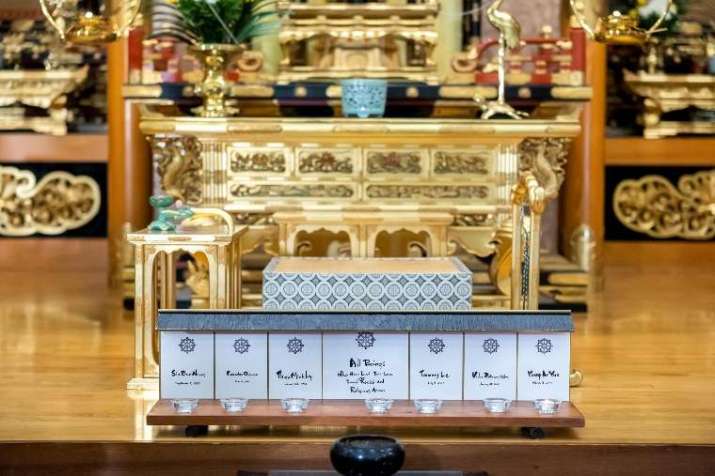 Memorial Tablets with names of six Asian American Buddhists killed in the US. Image courtesy of Tauran Photography, tauran.com
Memorial Tablets with names of six Asian American Buddhists killed in the US. Image courtesy of Tauran Photography, tauran.com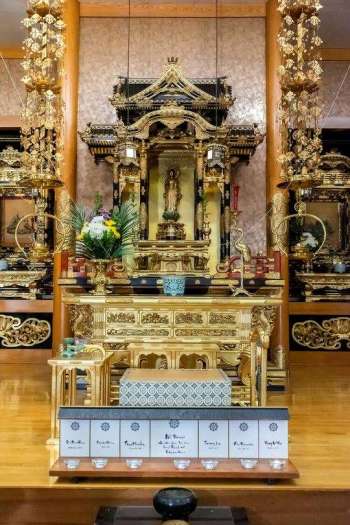 Shrine at Higashi Honganji in Little Tokyo, Los Angeles, USA. Image courtesy of Tauran Photography, tauran.com
Shrine at Higashi Honganji in Little Tokyo, Los Angeles, USA. Image courtesy of Tauran Photography, tauran.comBDG: Tell me what happened to your temple, in terms of the recent violence.
CH: The 4 May gathering was held at Higashi Honganji in Little Tokyo, Los Angeles, which was vandalized in late February. As the Los Angeles Times reported: “A 12-foot-high [3.7-meter] glass window was destroyed by a lime-sized rock; two six-foot [1.8-meter] wooden lantern stands were burned, causing the electrical lamps above them to melt and fray; and two 30-pound [14-kilogram] metallic lanterns were ripped off their concrete bases.” Just a few months prior, six Buddhist temples in LA’s Little Saigon were also vandalized. Bishop Ito of Higashi Honganji very generously agreed to host the 4 May event at his temple, which was restored thanks to a groundswell of community support.
BDG: How did you publicize “May We Gather?”
CH: After writing the invitation for the event, we reached out to temple leaders who were willing to be early endorsers. Our website went live shortly thereafter, allowing sanghas and individuals to list their names in support. We also encouraged people to share “May We Gather” on social media. Media outlets such as Buddhistdoor Global, Lion's Roar, Rafu Shimpo, Tricycle, and Ursache/Wirkung in Germany also helped to spread the word.
BDG: What kind of response did you receive?
CH: By 4 May, hundreds had signed on to indicate their support for “May We Gather.” Many talked about how important it felt to hold a ceremony of mourning, healing, and renewal in this time of grief, fear, and isolation.
Funie Hsu: The response was overwhelmingly positive. Duncan was wise to anticipate that people would greatly benefit from ceremony and ritual practice during this historic moment. Chenxing’s suggestion to organize the event around the 49th-day mourning tradition gave it a concrete significance that deeply resonated with Buddhists of many traditions, especially with many Asian and Asian American Buddhist communities who have long honored loved family members through 49th-day ceremonies. Because the response was so positive from early on, word spread quickly and this greatly helped with publicity for the event.
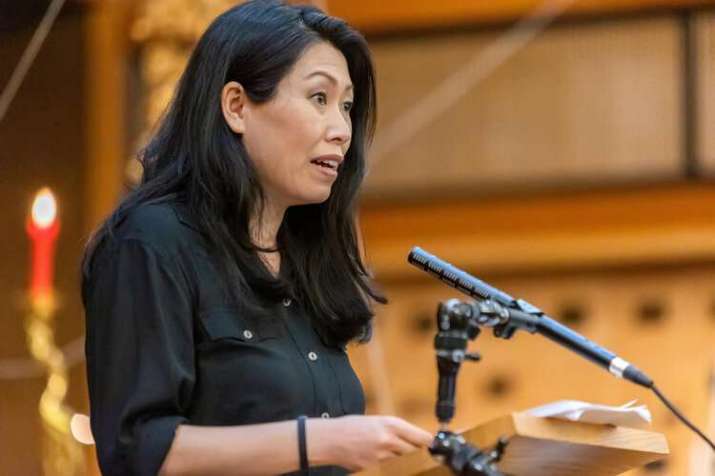 Funie Hsu. Image courtesy of Tauran Photography, tauran.com
Funie Hsu. Image courtesy of Tauran Photography, tauran.comDuncan Ryuken Williams: We received encouragement and support from every corner of the nation. From the oldest extant historic temples on the Hawai’ian Islands to Asian American temples in Atlanta, Georgia, where the horrific shooting took place, to small sanghas in rural Vermont and North Dakota. Some sanghas pledged to hold parallel ceremonies, Zoom discussions after the livestream, and otherwise come together in a wonderful spirit of solidarity.
BDG: Who were the co-presenters at the podium, both monastic and non-monastic?
CH: The event program lists the many monastic and lay Buddhists who participated in the “May We Gather” ceremony.* The ceremony included remarks from us as the three co-organizers; six Dharma messages by Bishop Noriaki Ito, Sister Kinh Nghiem, Bhante Sanathavihari, Bishop Myokei Caine-Barrett, Rev. Cristina Moon, and Dr. Larry Ward; and chanting in the Japanese, Sri Lankan, Chinese, Korean, Tibetan, and Thai Buddhist traditions.
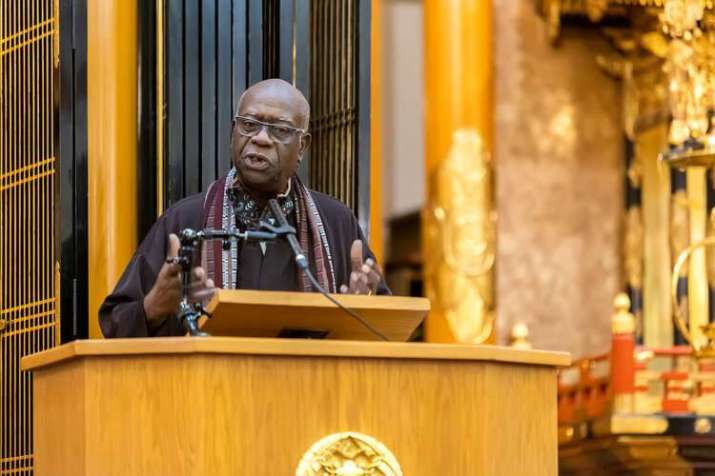 Dr. Larry Ward. Image courtesy of Tauran Photography, tauran.com
Dr. Larry Ward. Image courtesy of Tauran Photography, tauran.comDRW: As an Asian American-led gathering, we wanted to invite a diverse group of monastic and lay leaders who would have something to say about a Buddhist approach to dealing with hatred through loving-kindness and ignorance through wisdom. While we centered Asian American Buddhists, we also featured several Dharma messages from non-Asian American leaders who have acted as wonderful bridges, such as Bishop Myokei Caine-Barrett, who, as someone of both Asian American and African American heritage, has been doing amazing solidarity work in Texas. Others in this category included Larry Ward, a senior Dharma teacher in the Plum Village tradition, who has been a fantastic voice in healing America’s racial karma, as well as Bhante Sanathavihari, a Mexican American monk who serves a predominantly Sri Lankan American Buddhist community temple in LA, but has been instrumental in sharing the Dharma in Spanish to Southern California’s vast Latinx population. We felt it most apt to have him deliver his Dharma talk in Spanish, with English captioning for the livestream audience.
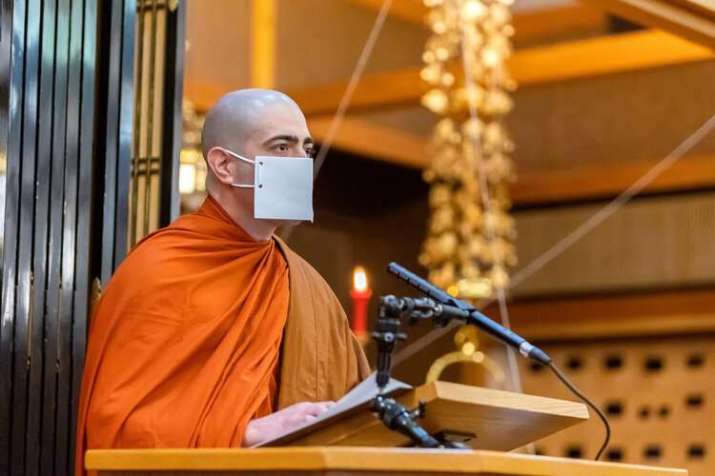 Bhante Sanathavihari. Image courtesy of Tauran Photography, tauran.com
Bhante Sanathavihari. Image courtesy of Tauran Photography, tauran.comBDG: What is the significance of the 49 days?
FH: Adding to what I mentioned earlier, I think part of the significance of the 49 days, in specific relation to “May We Gather,” has to do with the fact that many Asian and Asian American Buddhists of different traditions have mourned family members through 49th-day ceremonies for generations. I think the 49th-day mourning practice then served as an explicit and meaningful connection between understanding immediate family members as ancestors and holding dear those in our community who have died due to anti-Asian violence as also our ancestors, also our family. Moreover, in sharing this 49th-day practice, I think it helped to build a sense of a national and even a global community of Buddhists, even if the practice is not a part of all schools of Buddhism.
BDG: Why did you decide to livestream? How many people attended online?
CH: We know that so many people have been hurt—if not physically, then emotionally, psychologically, and spiritually—by violence caused by racial and religious animus, and we wanted a way for all of these people to participate in the ceremony. The actual in-person ceremony could not be open to the public due to COVID-19 restrictions, but the livestream made it possible to reach a much broader audience. More than 700 people attended live on 4 May, and the livestreamed video has been viewed more than 7,000 times.
DRW: There is power in place. To have gathered at a temple recently vandalized for this healing ceremony was important. But the power of broadcasting to a national and even international audience through the livestream was also palpable. To know that thousands of people and sanghas joined us simultaneously was a profound manifestation of how we can activate our American sangha to see each other as an interlinked community.
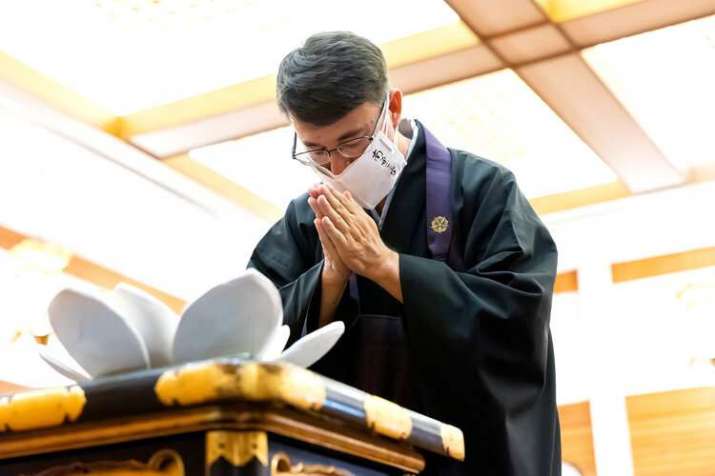 Duncan Ryuken Williams. Image courtesy of Tauran Photography, tauran.com
Duncan Ryuken Williams. Image courtesy of Tauran Photography, tauran.comBDG: It was historic to see this gathering of so many American Buddhist traditions and organizations. Why hasn’t something like this happened before?
CH: American Buddhists of Asian and non-Asian heritage have gathered across traditions before, such as for the annual Vesak holiday that commemorates the Buddha’s birth, enlightenment, and passing away into nirvana. Buddhists in America have also come together to speak out against climate change, hunger, anti-Black racism, and other issues of urgent concern. However, “May We Gather” was the first gathering we know of that has explicitly centered Asian American Buddhist leaders and addressed anti-Asian violence.
FH: The conditions haven’t always been right for an event like this. If people had tried to put together such an event, say even five years ago, I don’t think it would have resonated in the way that it did now. Unfortunately, had it not been for this most recent wave of violence against Asians and Asian Americans, and the fact that many of these incidents were caught on camera and widely shared on social media, the idea that Asian Americans and Asian American Buddhists suffer racial violence would not have been readily understood as a reality. I think even among some Asian Americans and Asian American Buddhists, it might have been a little bit of a tough event to sell.
Although the current wave of anti-Asian violence has brought incredible grief, it also has provided an opportunity for us to recognize that our Asian American Buddhists ancestors continuously dealt with such systemic violence since the time they first brought Buddhism to the United States in the 19th century, and their Buddhist practices helped them not only survive the violence but transform it into something that could deepen their practice. Given the recognition of the anti-Asian violence we’re experiencing now, we are able to draw from this legacy and host an event like “May We Gather” to transform our grieving in the 21st century and deepen our own practices.
DRW: The divides of national origin, lineage, language, and race can be overcome when we see and feel something deeper. The spirits of Yong Ae Yue, Vicha Ratanapakdee, and other Asian American Buddhist ancestors hurt by racial/religious animus whom we memorialized touched all of us sufficiently to bring us together. It shouldn’t take tragedies to prompt joining together, but I am very glad so many sanghas and individuals felt it to be a worthy gathering.
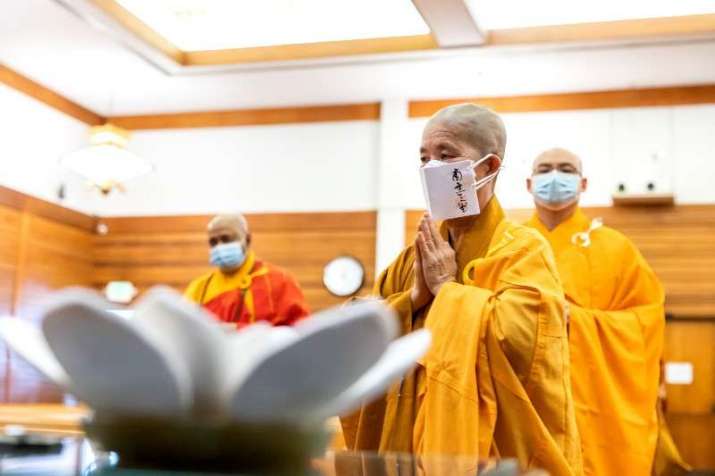 Buddhist monastics at May We Gather. Image courtesy of Tauran Photography, tauran.com
Buddhist monastics at May We Gather. Image courtesy of Tauran Photography, tauran.comBDG: Now that this event has potentially created cohesion within American Buddhism, what would you like to see going forward?
CH: We hope to see the creation of more events and spaces where American Buddhists, while rooted in different cultures and lineages, gather around a shared intention. We hope that more of these gatherings can occur in person as it becomes safe to do so. The 4 May event manifested our interconnectedness and kinship with each other, and we hope that these bonds of spiritual friendship can continue to deepen and grow.
FH: I hope to also see a meaningful and sustained change in the narrative of American Buddhism so that our Asian American ancestors are understood as just that, the ancestors of all those who practice American Buddhism. I hope to see more discussions that recognize how, in many ways, the history of American Buddhism has included surviving racial violence and other forms of systemic violence in the US. We can build powerful kinship from that recognition, and I hope it serves as a foundation for seeing the ways that other American Buddhists take refuge in the Buddhadharma as part of their survival and transformation of racial and systemic violence in the US.
BDG: Thank you Chenxing, Funie, and Duncan. May this sacred work continue.
* Video and Event Program (May We Gather)
Harsha Menon is an artist, filmmaker, scholar, writer, and a contributor to Buddhistdoor Global. She is an individual signatory to “May We Gather” and thanks her Dharma brother Sean Lee for first sharing the event.
See more
May We Gather
Chenxing Han
Funie Hsu
Duncan Ryuken Williams
Related features from Buddhistdoor Global
American Sutra: On the Incarceration of Japanese Americans in WWII
The Birth of an American Form of Buddhism: The Japanese-American Buddhist Experience in World War II
Julius Goldwater: Protector of Japanese American Buddhists
Fostering Compassion Through Breaking Bias: Anurag Gupta Asks Us to BE MORE
“Hyphenated-American”
Related news reports from Buddhistdoor Global
North American Buddhists to Offer Memorial Ceremony for Asian American Ancestors on 4 May
Buddhist Actress Chantal Thuy Recognized among Extraordinary Asian and Pacific Island Heritage Women
Rev. Marvin Harada, Bishop of Buddhist Churches of America, Reflects on the Rise of Asian Hate Crimes
More from About Buddhism in America by Harsha Menon
























